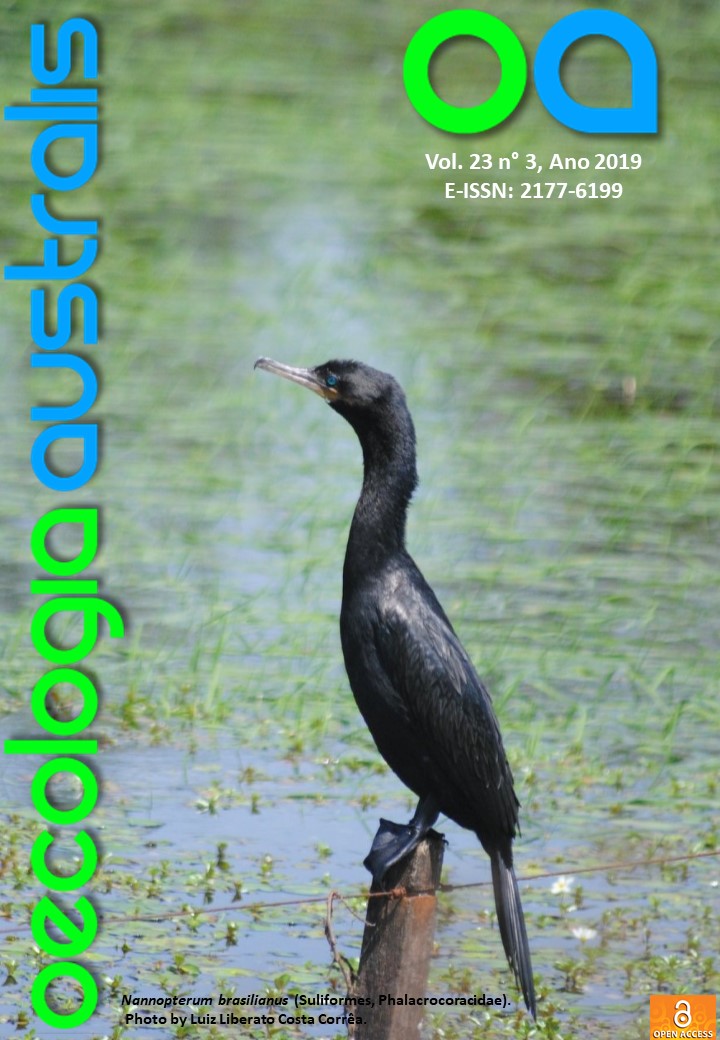FIRST RECORD OF VOCAL MIMICRY IN SCARLET-HEADED BLACKBIRD Amblyramphus holosericeus (AVES: PASSERIFORMES) IN THE SOUTHEASTERN BRAZIL
DOI:
https://doi.org/10.4257/oeco.2019.2303.23Keywords:
bioacoustics, dilution effect, Neotropical birds, vocal imitation, wetlandsAbstract
Vocal mimicry is the ability of some bird species to copy heterospecific vocalizations in order to establish deceptive or non-deceptive interactions between an emitter and a receiver. This kind of vocal behavior is well documented in several species of New World Blackbirds (Icteridae family), but not in Scarlet-headed Blackbird (Amblyramphus holosericeus). Here we report the first event of vocal mimicry of this species, where a single individual imitated the vocal signals of Smooth-billed Ani (Crotophaga ani; Cuculiformes, Cuculidae). We argue that such behavior could have a deceptive role, increasing the predation avoidance and foraging efficiency of A. holosericeus by luring heterospecific individuals to form a mixed-flock.
Downloads
References
Baylis, J. R. 1982. Avian vocal mimicry: its function and evolution. In: D. E. Kroodsma & E. H. Miller (Eds.), Acoustic communication in birds. Volume 2. pp. 51–80. New York: Academic Press.
Beecher, M. D., & Brenowitz, E. A. 2005. Functional aspects of song learning in songbirds. Trends in Ecology and Evolution, 20(3), 143–149. DOI: 10.1016/j.tree.2005.01.004.
Caro, T. M. 2005. Antipredator defense in birds and mammals. Chicaco: Chicago Academic Press: p. 591.
Cavassan, O. 2013. Bauru: terra de cerrado ou floresta? Ciência Geográfica, 17(1), 46–54.
Dalziell, A. H., Welbergen, J. A., Igic, B., & Magrath, R. D. 2015. Avian vocal mimicry: A unified conceptual framework. Biological Reviews, 90(2), 643–668. DOI: 10.1111/brv.12129
Dobkin, D. S. 1979. Functional and evolutionary relationships of vocal copying phenomena in birds. Zeitschrift Für Tierpsychologie, 50(4), 348–363. DOI: 10.1111/j.1439-0310.1979.tb01037.x
Durigan, G., Siqueira, M. F., & Franco, G. A. D. C. 2007. Threats to the Cerrado remnants of the state of São Paulo, Brazil. Scientia Agricola, 64(4), 355–363. DOI: 10.1590/S0103-90162007000400006
Fraga, R. M. 1987. Vocal mimicry in the Epaulet Oriole. The Condor, 89(1), 133–137. DOI: 10.2307/1368767
Fraga, R. M. 2011. Family Icteridae (New World blackbirds). In: J. del Hoyo, A. Eliott, & D. Christie (Eds.), Handbook of the birds of the world. Vol. 16. pp. 684–807. Barcelona: Lynx Editions.
Goodale, E., & Kotagama, S. W. 2006. Vocal mimicry by a passerine bird attracts other species involved in mixed-species flocks. Animal Behaviour, 72(2), 471–477. DOI: 10.1016/j.anbehav.2006.02.004
Hindmarsh, A. M. 1984. Vocal mimicry in starlings. Behaviour, 90(4), 302–324. DOI: 10.1163/156853984X00182
Junk, W. J. 2002. Long-term environmental trends and the future of tropical wetlands. Environmental Conservation, 29(4), 414–435. DOI: 10.1017/S0376892902000310
Kelley, L. A., Coe, R. L., Madden, J. R., & Healy, S. D. 2008. Vocal mimicry in songbirds. Animal Behaviour, 76(3), 521–528. DOI: 10.1016/j.anbehav.2008.04.012
Kroodsma, D. E., & Baylis, J. R. 1982. Appendix: A world survey of evidence for vocal learning in birds. In: D. E. Kroodsma & E. H. Miller (Eds.), Acoustic communication in birds. Vol. 2. pp. 311–337. New York: Academic Press.
Satischandra, S. H. K., Kudavidanage, E. P., Kotagama, S. W., & Goodale, E. 2007. The benefits of joining mixed-species flocks for greater racket-tailed drongos Dicrurus paradiseus. Forktail, 23(1), 145–148.
Thieltges, H., Henry, L., Biquand, V., & Deleporte, P. 2014. Short-term variations of dialects in short songs of two species of colonial caciques (Cacicus). Acta Acustica United with Acustica, 100(4), 759–766. DOI: 10.3813/AAA.918755
Todt, D. 1981. On functions of vocal matching: Effect of counter-replies on song post choice and singing. Zeitschrift Für Tierpsychologie, 57(1), 73–93.
Todt, D., & Naguib, M. 2000. Vocal interactions in birds: the use of song as a model in communication. In: P. J. B. Slater, J. S. Rosenblatt, C. T. Snowdon, & T. J. Roper (Eds.), Advances in the Study of Behaviour. Vol. 29. pp. 247–296. New York: Academic Press. DOI: 10.1016/S0065-3454(08)60107-2
Wickler, W. 2013. Understanding mimicry with special reference to vocal mimicry. Ethology, 119(4), 259–269. DOI: 10.1111/eth.12061
Wilman, H., Belmaker, J., Simpson, J., de la Rosa, C., Rivadeneira, M. M., & Jetz, W. 2014. EltonTraits 1.0: Species-level foraging attributes of the world’s birds and mammals. Ecology, 95(7), 2027–2027. DOI: 10.1890/13-1917.1


